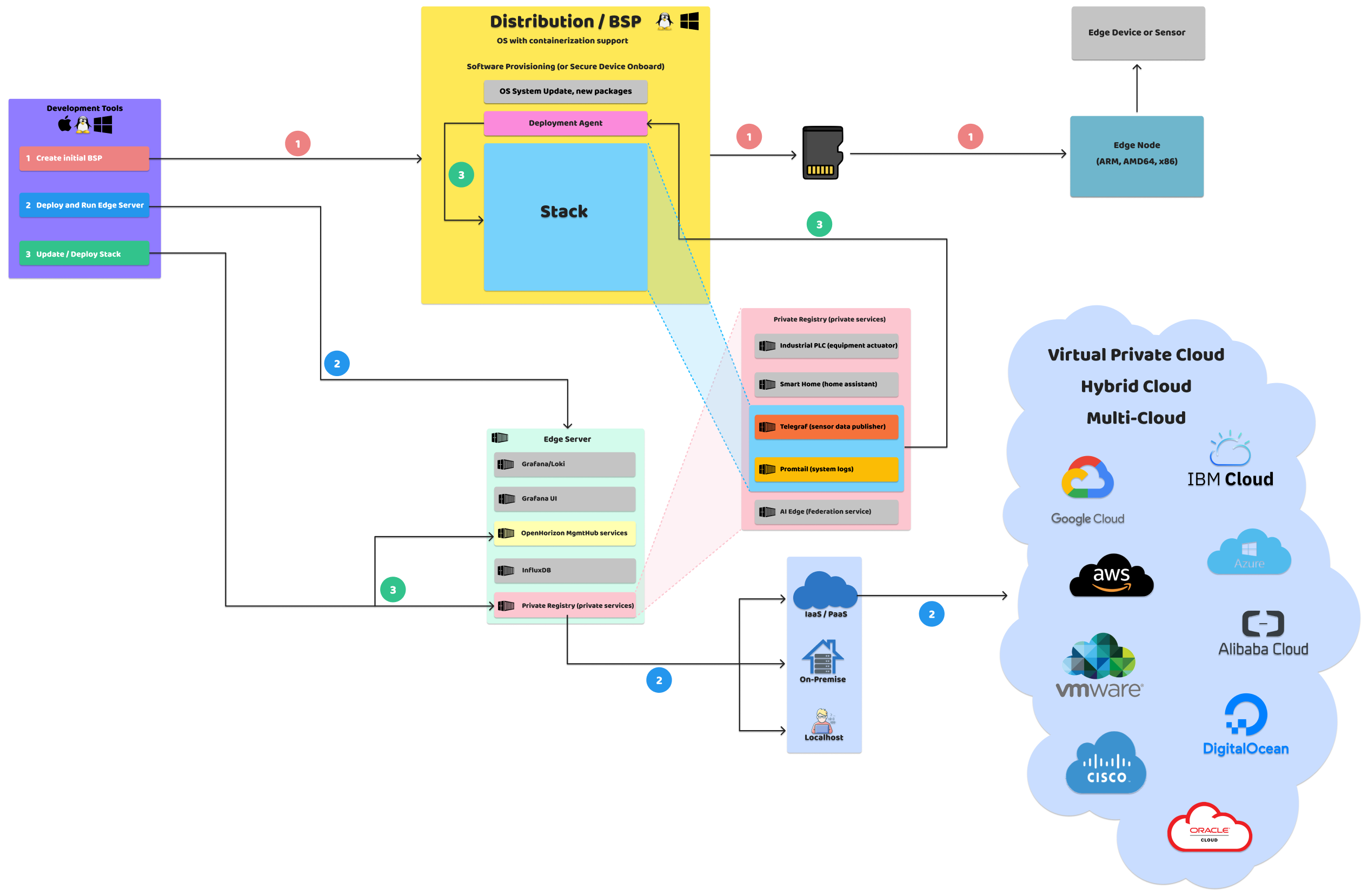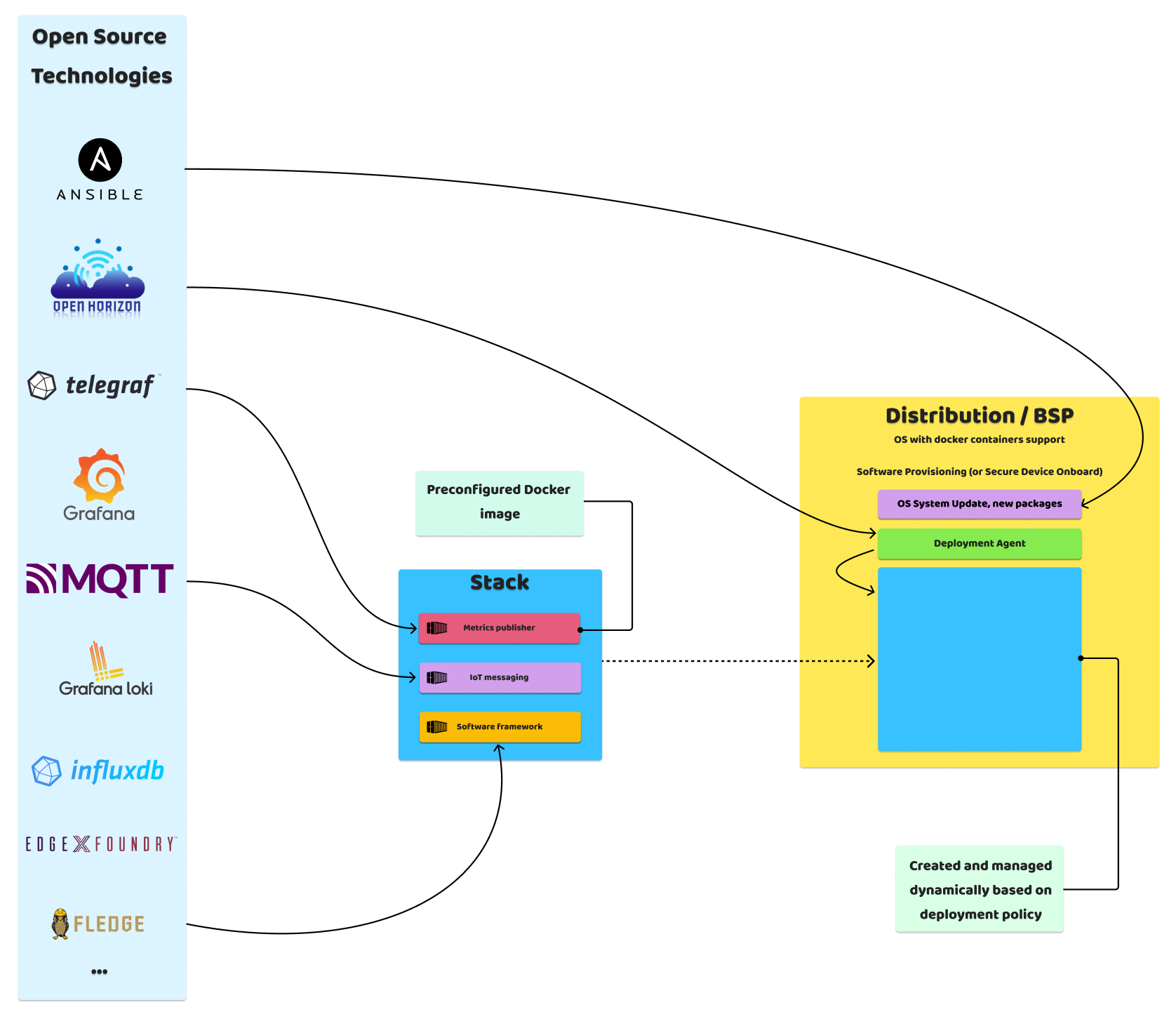Next step after using S-Soil MTEC-02B sensor in Milestone 2: Outdoor single sensor and saving telemetry data via Fledge software framework we will setup an framework where developers can add new sensors from scratch and build a new software stack to provide secure, private, zero-touch deployments to a subset of Edge Nodes (IoT devices) - we .
We will used RPi4 board for reference.
...
Being open sourced and customised, interested parties may use any cloud infrastructure which support containerised servers deployments i.e. GCP, AWS, Azure, IBM Cloud, Alibaba Cloud, Digital Ocean, Oracle Cloud, VMware Cloud, Cisco Cloud.
In this case the containerised services software is deployed with Open Horizon to RPi4 board.
Software engineers could build new sensors support and building a new software stacks after cloning SmartAg-foundation repo and going through the steps below.
<Insert video here>
Goals
- Build OS image with BSP distribution for Edge Node and save it to SD card. Insert SD card with BSP to RPi4 board and start controlling the board remotely.
[~10 minutes] - Run local Edge Server on developer workstation with all needed services for software development and zero touch deployment.
[~3 minutes]
- Connect/solder S-Soil MTEC-02B with USB to RS485 converter and insert into RPi4 board.
- Build a custom stack for S-Soil MTEC-02B to extract realtime data - Total Dissolved Solids (TDS), Temperature, Salinity, Volumetric Water Content (VWC) with python script, send data to Edge Server with Telegraf.
Deploy new stack remotely without touching the board to Edge Node (RPi4 board) from developer workstation.
Edge Server will collect data in InfluxDB and telemetry data will be available to display Grafana dashboard.
[~4 minutes] - Update stack and redeploy into the Edge Node remotely.
[~3 minutes]
Prerequisites
Hardware
- Raspberry Pi4 model B 4GB+ RAM
- Industrial Soil Moisture & Temperature & EC Sensor MODBUS-RTU RS485 (S-Soil MTEC-02B)
- 16+ GB micro SD Card
- Power supply for Raspberry Pi 4
- SD card reader
- x64 (development workstation)
- USB to RS485 converter (or similar like USB-RS485-WE-1800-BT)
Software
MacOS/Linux based developer host with installed Docker Desktop (TBD: add OCI compatible alternatives)
...
The stack consist of one or more preconfigured and tested software components which are running in isolated containers on the board and managed by Deployment Agent.
To provide more secure board management none IP ports are exposed from the board outside in production (this is configured when initial BSP image for the board is created).
Development tools is a docker image will help us it's intended to:
- Create initial BSP image and write it to SD card
- Run EdgeServer with Open Horizon services, Grafana, InfluxDB, Loki and onboard the Edge Device
- Create initial stack for development and further deployment to Edge Device
- Deploy stack on Edge Device by using business policy rule (Edge Device name as an example)
A single Edge Server (based on Open Horizon) may manage/update more than 10k of clusters or stand alone IoT devices acting as Edge Nodes.
Each Edge Node may control a dozens of wired or wireless Edge Devices (Arduino, STM32, ESP32, etc.) or sensors directly.
Here is a top view of ecosystem:
Also with added AI services, Edge Node may act as distributed AI node with federated learning capabilities.
Here is how the system components are deployed and updated:
- Create OS image with BSP installed and create disk image to be used in Edge Node
- Deploy and run Edge Server
- Update software stack on the Edge Node by building container images, uploading them to private registry server
(it can be a public registry as well, i.e. or public registry or available via DockerHub, Amazon ECR, Google GCR, Microsoft ACR, etc.)
An Edge Node software stack can be any set of:
...
Stack can be single or multiple containerised services working together and incorporating designed business logic.
Steps to configure
Clone SmartAg-foundation repo.
Build BSP image, write to SD card. Insert card and run Edge Node
Run Edge Server
Solder sensor and USB converter , insert sensor(described in p.6 from Milestone 2: Outdoor single sensor)
Create new example stack
Insert sensor to USB port of Edge Node
Build Create new stack, build stack to get retrieve data from sensors(Total Dissolved Solids (TDS), Temperature, Volumetric Water Content (VWC)) from S-Soil MTEC-02B, deploy
Configure Open Grafana from Edge Server, display telemetry data
Extend service with new logic to read soil salinity. Deploy and view new data on a dashboard.
- Connect/solder S-Soil MTEC-02B with USB to RS485 converter as shown below
- Insert USB to RS485 into RPi4 board as shown below (do not connect power)
- Clone GitHub repository with SmartAg-foundation and change directory to SmartAg-foundation/tools
git clone https://github.com/open-horizon-services/SmartAg-foundation SmartAg-foundation
cd SmartAg-foundation/tools - Download OS template image rename into target_os.img and put it into SmartAg-foundation/tools
- Insert 16Gb+ SD card in drive and create/write initial BSP image by running the following command (example-edge-node should be unique Edge Node for namefor your system):
sudo ./write_bsp_image example-edge-node
Enter SSID name, network password and confirm.
- After the BSP is written to disk, eject SD card, insert it into RPi4 and connect power.
After the board is initialised by default it will be running Fledge container from Milestone 2: Outdoor single sensor - Now let's create a custom stack with one containerised service telegraf and exec plugin which runs python script which in turn will read S-Soil MTEC-02B sensor data similar to what we did in fledge plugin in previous milestone.
./create_new_stack ../new_stack
By default new stack will contain a workable solution with telegraf and exec plugin for S-Soil MTEC-02B. - Before deploying a stack onto Edge Node, Edge Server needs to be started locally, to start Edge Server run:
./start_local_edgeserver
This script will register new Edge Node capabilities and run Edge Server containers. - To upload new_stack to the example-edge-node run the command, with Edge Node name (example-edge-node) and a new stack directory (new_stack):
./build_and_deploy example-edge-node ../new_stack
First time it will take few minutes to start.
<Add screenshots of Grafana>
...






